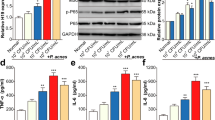Abstract
Objective
To suppress TNF-α-induced lipogenesis in sebocytes (associated with acne development) with microRNA-338-3p (miR-338-3p) and to explore the underlying mechanisms.
Results
TNF-α increased lipid droplet formation in sebocytes which were used as in vitro model of inflammation-induced acne. Flow cytometry and TLC assays validated that miR-338-3p could suppress TNF-α-induced lipid droplet formation, down-regulate the expression of PREX2a, and inactivate AKT signaling in sebocytes. In addition, suppression of AKT activity by the PI3 K and AKT inhibitors diminished TNF-α-induced lipogenesis. PREX2a siRNA mimics the effects of miR-338-3p on AKT phosphorylation and lipogenesis. PREX2a overexpression consistently restored lipogenesis and AKT phosphorylation attenuated by miR-338-3p.
Conclusions
MiR-338-3p suppresses the TNF-α-induced lipogenesis in sebocytes by targeting PREX2a and down-regulating PI3K/AKT signaling.




Similar content being viewed by others
References
Chen X, Pan M, Han L, Lu H, Hao X, Dong Q (2013) miR-338-3p suppresses neuroblastoma proliferation, invasion and migration through targeting PREX2a. FEBS Lett 587:3729–3737
Farrar MD, Ingham E (2004) Acne: inflammation. Clin Dermatol 22:380–384
Fine B et al (2009) Activation of the PI3K pathway in cancer through inhibition of PTEN by exchange factor P-REX2a. Science 325:1261–1265. doi:10.1126/science.1173569
Hanada T, Yoshimura A (2002) Regulation of cytokine signaling and inflammation. Cytok Growth Factor Rev 13:413–421
Harvey A, Huynh TT (2014) Inflammation and acne: putting the pieces together. J Drug Dermatol 13:459–463
Kang S, Cho S, Chung JH, Hammerberg C, Fisher GJ, Voorhees JJ (2005) Inflammation and extracellular matrix degradation mediated by activated transcription factors nuclear factor-kappaB and activator protein-1 in inflammatory acne lesions in vivo. Am J Pathol 166:1691–1699
Kitade Y, Akao Y (2010) MicroRNAs and their therapeutic potential for human diseases: microRNAs, miR-143 and -145, function as anti-oncomirs and the application of chemically modified miR-143 as an anti-cancer drug. J Pharmacol Sci 114:276–280
Landskron G, De la Fuente M, Thuwajit P, Thuwajit C, Hermoso MA (2014) Chronic inflammation and cytokines in the tumor microenvironment. J Immunol Res 2014:149185. doi:10.1155/2014/149185
Webster GF (1995) Inflammation in acne vulgaris. J Am Acad Dermatol 33:247–253
Xia LQ, Zouboulis C, Detmar M, Mayer-da-Silva A, Stadler R, Orfanos CE (1989) Isolation of human sebaceous glands and cultivation of sebaceous gland-derived cells as an in vitro model. J Invest Dermatol 93:315–321
Yoshimura A, Mori H, Ohishi M, Aki D, Hanada T (2003) Negative regulation of cytokine signaling influences inflammation. Curr Opin Immunol 15:704–708
Funding
This study was funded by Heilongjiang province scientific research institution innovation Grants (YC2016D002).
Author information
Authors and Affiliations
Corresponding author
Ethics declarations
Conflict of interest
The authors declare that they have no conflict of interest.
Rights and permissions
About this article
Cite this article
Liu, J., Cao, L., Feng, Y. et al. MiR-338-3p inhibits TNF-α-induced lipogenesis in human sebocytes. Biotechnol Lett 39, 1343–1349 (2017). https://doi.org/10.1007/s10529-017-2369-3
Received:
Accepted:
Published:
Issue Date:
DOI: https://doi.org/10.1007/s10529-017-2369-3




